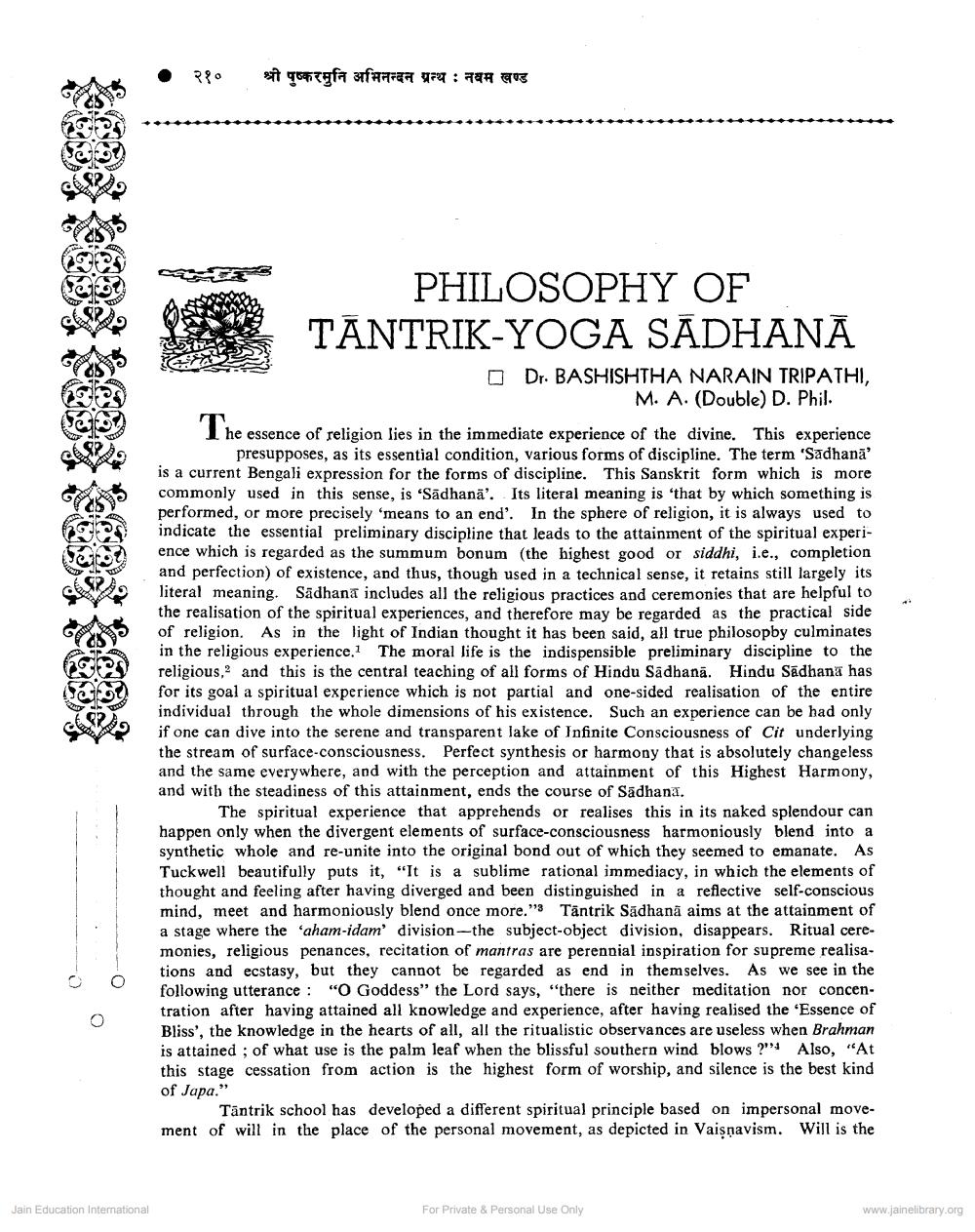Book Title: Philosophy of Tantrik Yoga Sadhna Author(s): Vaishishtha Narain Tripathi Publisher: Z_Pushkarmuni_Abhinandan_Granth_012012.pdf View full book textPage 1
________________ 300 ார் Jain Education International २१० श्री पुष्कर मुनि अभिनन्दन ग्रन्थ : नवम खण्ड PHILOSOPHY OF TANTRIK-YOGA SADHANA 0 Dr. BASHISHTHA NARAIN TRIPATHI, M. A. (Double) D. Phil. The essence of religion lies in the immediate experience of the divine. This experience presupposes, as its essential condition, various forms of discipline. The term 'Sadhana' is a current Bengali expression for the forms of discipline. This Sanskrit form which is more commonly used in this sense, is 'Sadhana'. Its literal meaning is 'that by which something is performed, or more precisely 'means to an end'. In the sphere of religion, it is always used to indicate the essential preliminary discipline that leads to the attainment of the spiritual experience which is regarded as the summum bonum (the highest good or siddhi, i.e., completion and perfection) of existence, and thus, though used in a technical sense, it retains still largely its literal meaning. Sadhana includes all the religious practices and ceremonies that are helpful to the realisation of the spiritual experiences, and therefore may be regarded as the practical side of religion. As in the light of Indian thought it has been said, all true philosopby culminates in the religious experience.1 The moral life is the indispensible preliminary discipline to the religious, and this is the central teaching of all forms of Hindu Sadhana. Hindu Sadhana has for its goal a spiritual experience which is not partial and one-sided realisation of the entire individual through the whole dimensions of his existence. Such an experience can be had only if one can dive into the serene and transparent lake of Infinite Consciousness of Cit underlying the stream of surface-consciousness. Perfect synthesis or harmony that is absolutely changeless and the same everywhere, and with the perception and attainment of this Highest Harmony, and with the steadiness of this attainment, ends the course of Sadhana. The spiritual experience that apprehends or realises this in its naked splendour can happen only when the divergent elements of surface-consciousness harmoniously blend into a synthetic whole and re-unite into the original bond out of which they seemed to emanate. As Tuckwell beautifully puts it, "It is a sublime rational immediacy, in which the elements of thought and feeling after having diverged and been distinguished in a reflective self-conscious mind, meet and harmoniously blend once more." Tantrik Sadhanā aims at the attainment of a stage where the 'aham-idam' division-the subject-object division, disappears. Ritual ceremonies, religious penances, recitation of mantras are perennial inspiration for supreme realisations and ecstasy, but they cannot be regarded as end in themselves. As we see in the following utterance: "O Goddess" the Lord says, "there is neither meditation nor concentration after having attained all knowledge and experience, after having realised the 'Essence of Bliss', the knowledge in the hearts of all, all the ritualistic observances are useless when Brahman is attained; of what use is the palm leaf when the blissful southern wind blows ?" Also, "At this stage cessation from action is the highest form of worship, and silence is the best kind of Japa." Tantrik school has developed a different spiritual principle based on impersonal movement of will in the place of the personal movement, as depicted in Vaisnavism. Will is the For Private & Personal Use Only www.jainelibrary.orgPage Navigation
1 2 3 4 5 6 7 8 9
